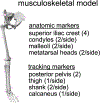Experimental recommendations for estimating lower extremity loading based on joint and activity
- PMID: 34461365
- PMCID: PMC8643134
- DOI: 10.1016/j.jbiomech.2021.110688
Experimental recommendations for estimating lower extremity loading based on joint and activity
Abstract
Researchers often estimate joint loading using musculoskeletal models to solve the inverse dynamics problem. This approach is powerful because it can be done non-invasively, however, it relies on assumptions and physical measurements that are prone to measurement error. The purpose of this study was to determine the impact of these errors - specifically, segment mass and shear ground reaction force - have on analyzing joint loads during activities of daily living. We performed traditional marker-based motion capture analysis on 8 healthy adults while they completed a battery of exercises on 6 degree of freedom force plates. We then scaled the mass of each segment as well as the shear component of the ground reaction force in 5% increments between 0 and 200% and iteratively performed inverse dynamics calculations, resulting in 1681 mass-shear combinations per activity. We compared the peak joint moments of the ankle, knee, and hip at each mass-shear combination to the 100% mass and 100% shear combination to determine the percent error. We found that the ankle was most resistant to changes in both mass and shear and the knee was resistant to changes in mass while the hip was sensitive to changes in both mass and shear. These results can help guide researchers who are pursuing lower-cost or more convenient data collection setups.
Keywords: Biomechanics; Inverse dynamics; Low-cost data collection; Run; Sensitivity analysis; Walk.
Copyright © 2021. Published by Elsevier Ltd.
Figures



References
-
- Arnold AS, Delp SL, 2005. Computer modeling of gait abnormalities in cerebral palsy: application to treatment planning. Theor. Issues Ergon. Sci. 6, 305–312. 10.1080/14639220412331329636 - DOI
Publication types
MeSH terms
Grants and funding
LinkOut - more resources
Full Text Sources

